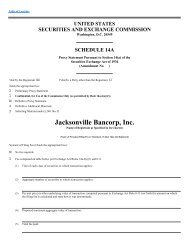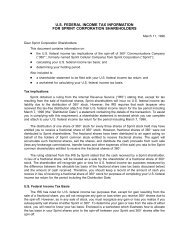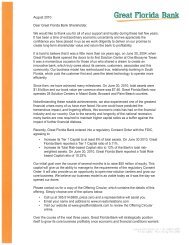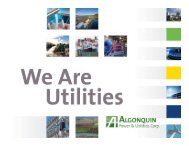Cousins Properties Incorporated 2006 Annual Report - SNL Financial
Cousins Properties Incorporated 2006 Annual Report - SNL Financial
Cousins Properties Incorporated 2006 Annual Report - SNL Financial
Create successful ePaper yourself
Turn your PDF publications into a flip-book with our unique Google optimized e-Paper software.
For the foreseeable future, the Company expects to continue to pursue its business model by focusing much of<br />
its efforts on creating value through development. Management believes that this strategy has been successful in the<br />
past and should continue to maximize the total return to stockholders.<br />
Critical Accounting Policies. The Company’s financial statements are prepared in accordance with<br />
accounting principles generally accepted in the United States of America, and the Notes to Consolidated <strong>Financial</strong><br />
Statements included in Item 8 herein include a summary of the significant accounting policies for the Company. A<br />
critical accounting policy is one which is both important to the portrayal of a company’s financial condition and<br />
results of operations and requires significant judgment or complex estimation processes. The Company is in the<br />
business of developing, owning and managing office, retail and industrial real estate properties, developing multifamily<br />
residential units, and developing single-family residential communities which are parceled into lots and sold<br />
to various home builders. The Company’s critical accounting policies relate to its long lived assets, including cost<br />
capitalization, acquisition of operating property, depreciation and amortization, and impairment of long-lived<br />
assets (including investments in unconsolidated joint ventures); revenue recognition, including residential lot sales,<br />
land tract sales, multi-family residential unit sales and valuation of receivables; and to accounting for investments in<br />
non-wholly owned entities.<br />
Long-Lived Assets<br />
Cost Capitalization. The Company is involved in all stages of real estate development. The Company<br />
expenses predevelopment expenses incurred on a potential project until it becomes probable (more likely than not at<br />
the point the decision is made) that the project will go forward. After the Company determines the project is<br />
probable, all subsequently incurred predevelopment costs, as well as interest, real estate taxes and certain internal<br />
personnel and associated costs directly related to the project under development, are capitalized in accordance with<br />
Statement of <strong>Financial</strong> Accounting Standards (“SFAS”) No. 34 “Capitalization of Interest Cost” and SFAS No. 67<br />
“Accounting for Costs and the Initial Rental Operations of Real Estate <strong>Properties</strong>.” If the project’s probability<br />
comes into question, a reserve may be placed on the assets. If the decision is made to abandon development of a<br />
project that had been deemed probable, all previously capitalized costs are expensed or charged against the reserve,<br />
if one was established. Therefore, a change in the probability of a project could result in the expensing of significant<br />
costs incurred for predevelopment activity. The Company had approximately $17.5 million of capitalized<br />
predevelopment assets as of December 31, <strong>2006</strong>.<br />
At the time the Company determines that a development project is probable, the Company estimates the time<br />
and cost of construction to complete the project. A change in the estimated time and cost of construction could<br />
adversely impact the return on the project and the amount of value created from the development of the project.<br />
Additionally, determination of when construction of a project is substantially complete and held available for<br />
occupancy requires judgment. In accordance with SFAS Nos. 34 and 67, the Company capitalizes direct and related<br />
indirect project costs associated with development projects during the construction period. Once a project is<br />
deemed substantially complete and held for occupancy, subsequent carrying costs, such as real estate taxes, interest,<br />
internal personnel and associated costs, are expensed as incurred. The Company considers projects and/or project<br />
phases substantially complete and held for occupancy at the earlier of the date on which the phase reached<br />
occupancy of 95% or one year from the issuance of a certificate of occupancy. The Company’s judgment of the date<br />
the project is substantially complete has a direct impact on the Company’s operating expenses and net income for<br />
the period.<br />
Acquisition of Operating Property. In addition to developing properties for investment purposes, the<br />
Company also occasionally acquires completed and operating properties. The Company allocates the purchase<br />
price of operating properties acquired to land, building, tenant improvements and identifiable intangible assets and<br />
liabilities based upon relative fair value at the date of acquisition in accordance with SFAS No. 141, “Accounting<br />
for Business Combinations,” which requires considerable judgment. The Company assesses fair value based on<br />
estimated cash flow projections that utilize appropriate discount and/or capitalization rates. Estimates of future cash<br />
flows are based on a number of assumptions including hypothetical expected lease-up periods, known and<br />
anticipated trends, and local market and economic conditions, including probability of lease renewal and estimated<br />
lease terms. The fair value of the tangible assets of an acquired operating property, including land, building and<br />
tenant improvements, considers the value of the property as if it were vacant. Intangible assets can consist of above<br />
38

















